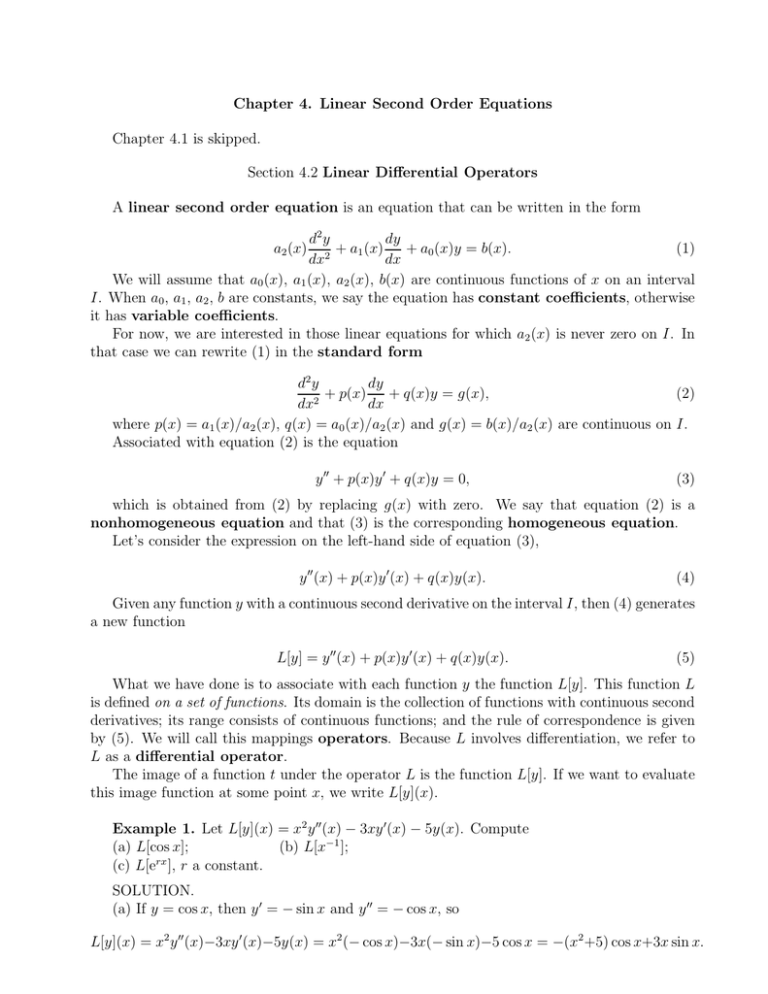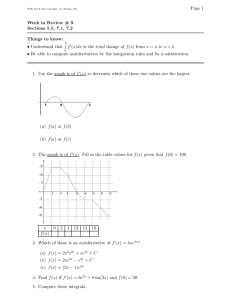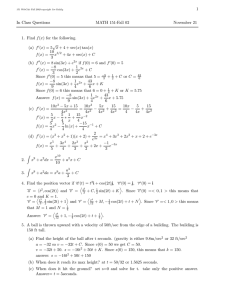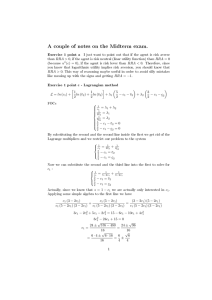Chapter 4. Linear Second Order Equations Chapter 4.1 is skipped.
advertisement

Chapter 4. Linear Second Order Equations
Chapter 4.1 is skipped.
Section 4.2 Linear Differential Operators
A linear second order equation is an equation that can be written in the form
dy
d2 y
+ a1 (x) + a0 (x)y = b(x).
(1)
2
dx
dx
We will assume that a0 (x), a1 (x), a2 (x), b(x) are continuous functions of x on an interval
I. When a0 , a1 , a2 , b are constants, we say the equation has constant coefficients, otherwise
it has variable coefficients.
For now, we are interested in those linear equations for which a2 (x) is never zero on I. In
that case we can rewrite (1) in the standard form
a2 (x)
d2 y
dy
+ p(x) + q(x)y = g(x),
(2)
2
dx
dx
where p(x) = a1 (x)/a2 (x), q(x) = a0 (x)/a2 (x) and g(x) = b(x)/a2 (x) are continuous on I.
Associated with equation (2) is the equation
y ′′ + p(x)y ′ + q(x)y = 0,
(3)
which is obtained from (2) by replacing g(x) with zero. We say that equation (2) is a
nonhomogeneous equation and that (3) is the corresponding homogeneous equation.
Let’s consider the expression on the left-hand side of equation (3),
y ′′ (x) + p(x)y ′ (x) + q(x)y(x).
(4)
Given any function y with a continuous second derivative on the interval I, then (4) generates
a new function
L[y] = y ′′(x) + p(x)y ′ (x) + q(x)y(x).
(5)
What we have done is to associate with each function y the function L[y]. This function L
is defined on a set of functions. Its domain is the collection of functions with continuous second
derivatives; its range consists of continuous functions; and the rule of correspondence is given
by (5). We will call this mappings operators. Because L involves differentiation, we refer to
L as a differential operator.
The image of a function t under the operator L is the function L[y]. If we want to evaluate
this image function at some point x, we write L[y](x).
Example 1. Let L[y](x) = x2 y ′′ (x) − 3xy ′(x) − 5y(x). Compute
(a) L[cos x];
(b) L[x−1 ];
(c) L[erx ], r a constant.
SOLUTION.
(a) If y = cos x, then y ′ = − sin x and y ′′ = − cos x, so
L[y](x) = x2 y ′′ (x)−3xy ′ (x)−5y(x) = x2 (− cos x)−3x(− sin x)−5 cos x = −(x2 +5) cos x+3x sin x.
Thus, L maps the function cos x to the function −(x2 + 5) cos x + 3x sin x.
(b) If y = x−1 , then we similarly find
1
1
2 3 5
2
L[y](x) = x y (x) − 3xy (x) − 5y(x) = x 3 − 3x − 2 − 5 = + − = 0.
x
x
x
x x x
2 ′′
2
′
Thus, L maps the function x−1 to the zero function (or y = x−1 is the solution to the
equation x2 y ′′ (x) − 3xy ′(x) − 5y(x) = 0).
(c) If y = erx ,
L[y](x) = x2 y ′′ (x) − 3xy ′ (x) − 5y(x) = x2 r 2 erx − 3xrerx − 5erx = ((xr)2 − 3xr − 5)erx .
Thus, L maps the function erx to the function ((xr)2 − 3xr − 5)erx .
The differential operator L defined by (5) has two very important properties.
Lemma 1. Let L[x] = y ′′(x) + p(x)y ′ (x) + q(x)y(x). If y, y1 , and y2 are any twicedifferentiable functions on the interval I and if c is any constant, then
L[y1 + y2 ] = L[y1 ] + L[y2 ],
(6)
L[cy] = cL[y].
(7)
Proof. On I, we have
L[y1 + y2 ] = (y1 + y2 )′′ + p(x)(y1 + y2 )′ + q(x)(y1 + y2 ) = (y1′′ + y2′′ ) + p(x)(y1′ + y2′ ) + q(x)(y1 + y2 ) =
(y1′′ + p(x)y1′ + q(x)y1 ) + (y2′′ + p(x)y2′ + q(x)y2 ) = L[y1 ] + L[y2 ],
which verifies property (6).
Similarly we can prove property (7).
Any operator that satisfied satisfies properties (6) and (7) for any constant c and any
functions y, y1 , and y2 in its domain is called a linear operator and we can say that ”L
preserves linear combination”. If (6) or (7) fails to hold, the operator is nonlinear.
Lemma 1 says that the operator L, defined by (5) is linear.
Example 2. Show that T defined by
T [y] = y ′′ + {y ′y 2 }1/3
is a nonlinear.
SOLUTION. To demonstrate that T is nonlinear, it suffices to show that property (6) (or
(7)) is not always satisfied. Let’s try y1 (x) = x2 and y2 (x) = x3 . Since y1′ (x) = 2x, y1′ (x) = 2,
y2′ (x) = 3x2 , y2′′(x) = 6x,
T [y1 ] = 2 + {2x · x4 }1/3 = 2 + {2x5 }1/3 ,
T [y2 ] = 6x + {3x2 · x6 }1/3 = 6x + {3x8 }1/3 ,
T [y1 + y2 ] = 2 + 6x + {(2x5 + 3x8 )(x2 + x3 )2 }1/3 6= 2 + {2x5 }1/3 + 6x + {3x7 }1/3 ,
so T [y1 ] + T [y2 ] 6= T [y1 + y2 ], property (6) is violated. Hence, T is a nonlinear operator.
The linearity of the differential operator L in (5) can be used to prove the following theorem
concerning homogeneous equations.
Theorem 1 (linear combination of solutions). Let y1 and y2 be solutions to the
homogeneous equation (3). Then any linear combination C1 y1 + C2 y2 of y1 and y2 , where C1
and C2 are constants, is also the solution to (3).
Proof. Since y1 and y2 are solutions to (3), then L[y1 ] = 0 and L[y2 ] = 0. Using the
linearity of L, we have
L[C1 y1 + C2 y2 ] = L[C1 y1 ] + L[C2 y2 ] = C1 L[y1 ] + C2 L[y2 ] = 0
for any C1 and C2 . Thus, C1 y1 + C2 y2 is a solution to (3).
Example 3. Given that y1 (x) = e2x cos x and y2 (x) = e2x sin x are solutions to the homogeneous equation
y ′′ − 4y ′ + 5y = 0,
find solutions to this equation that satisfy the following initial conditions:
(a) y(0) = 2, y ′(0) = 1.
(b) y(π) = 4e2π , y ′ (π) = 5e2π .
SOLUTION. As a consequence of T.1, any linear combination
y(x) = C1 e2x cos x + C2 e2x sin x
with C1 and C2 arbitrary consrants, will be the solution also.
y ′(x) = 2C1 e2x cos x − C1 e2x sin x + 2C2 e2x sin x + C2 e2x cos x =
(2C1 + C2 )e2x cos x + (2C2 − C1 )e2x sin x.
(a)
y(0) = C1 (1)(1) + C2 (1)(0) = C1 = 2,
y ′ (0) = (2C1 + C2 )(1) + (2C2 − C1 )(0) = 2C1 + C2 = 1.
Since C2 = 1 − 2C1 and C1 = 2, C2 = −3. Hence, the solution to the given initial value
problem is
y(x) = 2e2x cos x − 3e2x sin x.
(b)
y(π) = C1 e2π (−1) + C2 e2π (0) = −C1 e2π = 4e2π ,
so, C1 = −4.
y ′ (π) = (2C1 + C2 )e2π (−1) + (2C2 − C1 )e2π (0) = −(2C1 + C2 )e2π = 5e2π ,
so, 2C1 + C2 = −5. Since C2 = −5 − 2C1 and C1 = −4, C2 = 3. Hence, the solution to the
given initial value problem is
y(x) = −4e2x cos x + 3e2x sin x.





